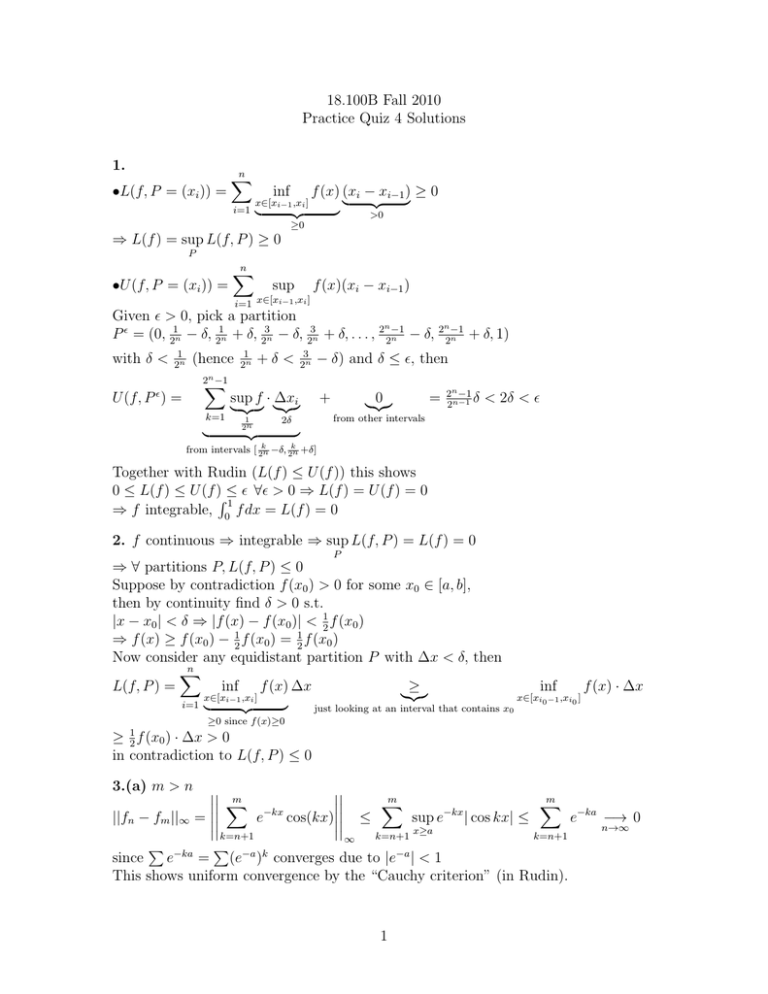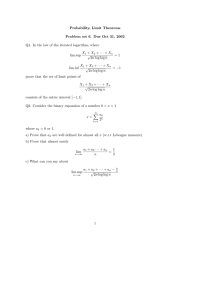Document 13438167
advertisement

18.100B Fall 2010 Practice Quiz 4 Solutions 1. • L(f, P = (xi )) = n � i=1 inf x∈[xi−1 ,xi ] � �� ≥0 f (x) (xi − xi−1 ) ≥ 0 � �� � � >0 ⇒ L(f ) = sup L(f, P ) ≥ 0 P •U (f, P = (xi )) = n � f (x)(xi − xi−1 ) sup i=1 x∈[xi−1 ,xi ] Given � > 0, pick a partition n n P � = (0, 21n − δ, 21n + δ, 23n − δ, 23n + δ, . . . , 2 2−1 − δ, 2 2−1 + δ, 1) n n with δ < 1 2n (hence 1 2n +δ < 3 2n − δ) and δ ≤ �, then 2n −1 U (f, P � ) = � k=1 � sup f · Δx � �� � ����i 1 2n 2δ �� + 0 ���� = 2n −1 δ 2n−1 < 2δ < � from other intervals � from intervals [ 2kn −δ, 2kn +δ] Together with Rudin (L(f ) ≤ U (f )) this shows 0 ≤ L(f ) ≤ U (f )� ≤ � ∀� > 0 ⇒ L(f ) = U (f ) = 0 1 ⇒ f integrable, 0 f dx = L(f ) = 0 2. f continuous ⇒ integrable ⇒ sup L(f, P ) = L(f ) = 0 P ⇒ ∀ partitions P, L(f, P ) ≤ 0 Suppose by contradiction f (x0 ) > 0 for some x0 ∈ [a, b], then by continuity find δ > 0 s.t. |x − x0 | < δ ⇒ |f (x) − f (x0 )| < 12 f (x0 ) ⇒ f (x) ≥ f (x0 ) − 12 f (x0 ) = 12 f (x0 ) Now consider any equidistant partition P with Δx < δ, then n � L(f, P ) = inf f (x) Δx ≥ inf f (x) · Δx ���� x∈[xi−1 ,xi ] x∈[xi0 −1 ,xi0 ] i=1 � �� � just looking at an interval that contains x0 ≥0 since f (x)≥0 ≥ 12 f (x0 ) · Δx > 0 in contradiction to L(f, P ) ≤ 0 3.(a) m > n �� �� m m m �� � �� � � �� �� ||fn − fm ||∞ = �� e−kx cos(kx)�� ≤ sup e−kx | cos kx| ≤ e−ka −→ 0 n→∞ �� �� x≥a k=n+1 k=n+1 k=n+1 ∞ � −ka � −a k since e = (e ) converges due to |e−a | < 1 This shows uniform convergence by the “Cauchy criterion” (in Rudin). 1 (b) To show that f is continuous at x0 ∈ (0, ∞), note that • each fn is continuous on [ x20 , 2x0 ] •fn → f uniformly on [ x20 , 2x0 ] by (a) So, by Rudin, f is continuous on [ x20 , 2x0 ], which contains x0 . (c) � ∞ � f (x)dx 1 = b lim by definition b→∞ f (x)dx 1 � b lim n→∞ fn (x)dx 1 = lim linearity of integral n→∞ absolutely convergent series ∞ � b � = lim lim by Rudin b→∞ n→∞ b � � k=1 fn (x)dx 1 1 −kx cos kx� dx exists by comparison with the �e �� |·|≤e−kx e−k , and k=1 �� b � � � � � � � � �b � n � −1 −kx �b � n 1 −k � b −kx n � � f (x)dx = lim f (x)dx ≤ e dx = ≤ k=1 k e � � n→∞ n k=1 1 k=1 k e 1 � � 1 1 n � �k ∞ � �k � � 1 1 1 e ≤ ≤ = 1 = e e e−1 1− e k=1 �k=1 b Similarly, lim f dx exists since for b� ≥ b b→∞ 1 �� � � � b � b � �� � � � � � � � � b � 1 −bk 1 −b k f dx − f dx� = limn→∞ � b fn dx� ≤ ∞ − e−b k ) ≤ ∞ � k=1 k (e k=1 (e ) = 1−e−b � 1 � 1 converges to 0 as b → ∞. (Hence the same holds for any sequence bi → ∞, making f dx a Cauchy sequence. Completeness of R then implies convergence as i → ∞; and 1 the limit for all sequences bi → ∞ is the same since otherwise one could make a divergence (oscillating) sequence.) � b � ∞ � ∞ e e . So f dx exists, and f dx = lim f dx ≤ lim = b→∞ b→∞ e−1 e−1 1 1 1 � bi 4.(a) FALSE Differentiable implies continuous, but not bounded - e.g. f (x) = x−1 on [0, 1] is differen­ tiable on (0,1). (b) TRUE See Rudin. (c) TRUE � L(f, P ) = � inf f (x) �� � x∈[xi−1 ,xi ] � ·Δxi ≤ 0 ⇒ L(f ) = f dx ≤ 0 ≤0 since any interval contains x∈R\Q (d) TRUE The limit is continuous by Rudin 7.. . . , and uniformly continuous since [a,b] is compact 2 (e) TRUE Almost everywhere continuous ⇐⇒ Riemann integrable So result follows from “fn ∈ R, ||fn − f ||∞ → 0 ⇒ f ∈ R” 3 MIT OpenCourseWare http://ocw.mit.edu 18.100B Analysis I Fall 2010 For information about citing these materials or our Terms of Use, visit: http://ocw.mit.edu/terms.




